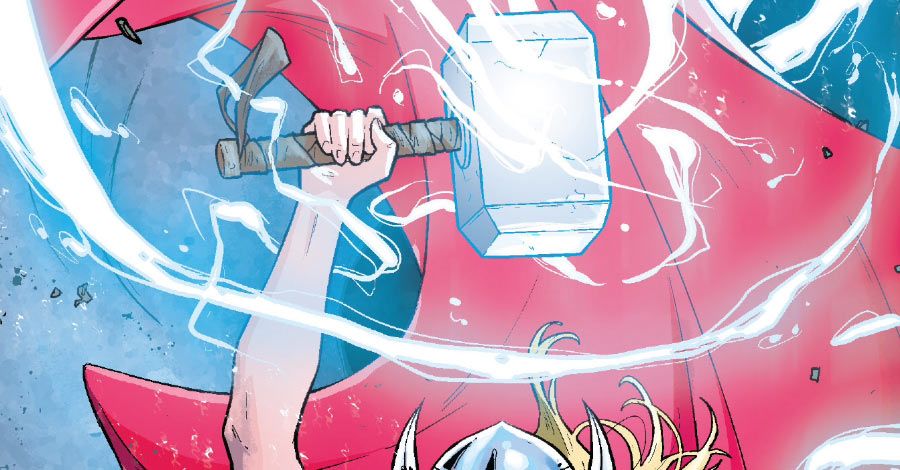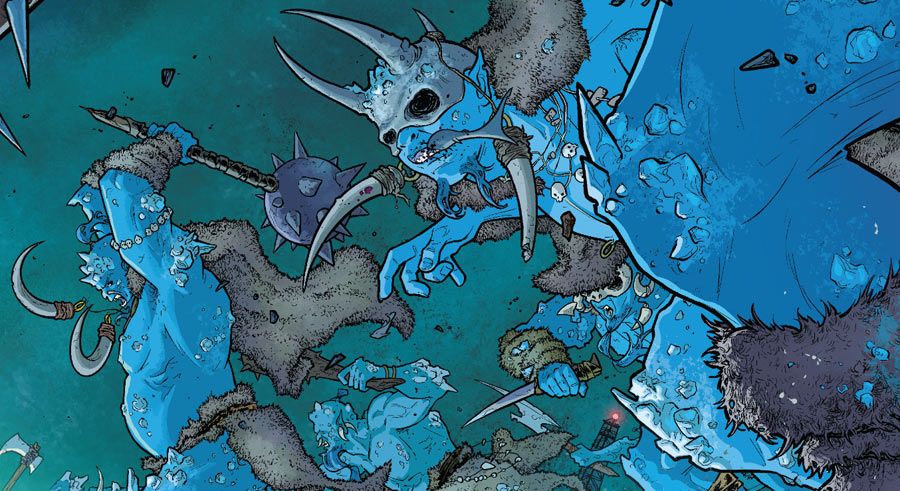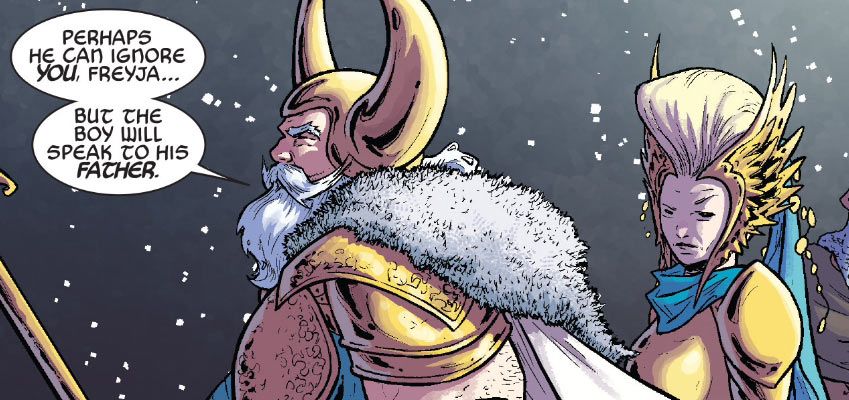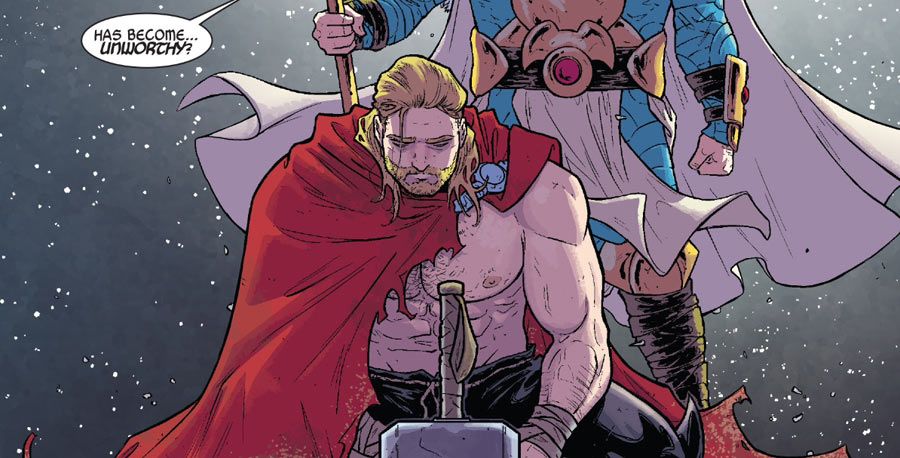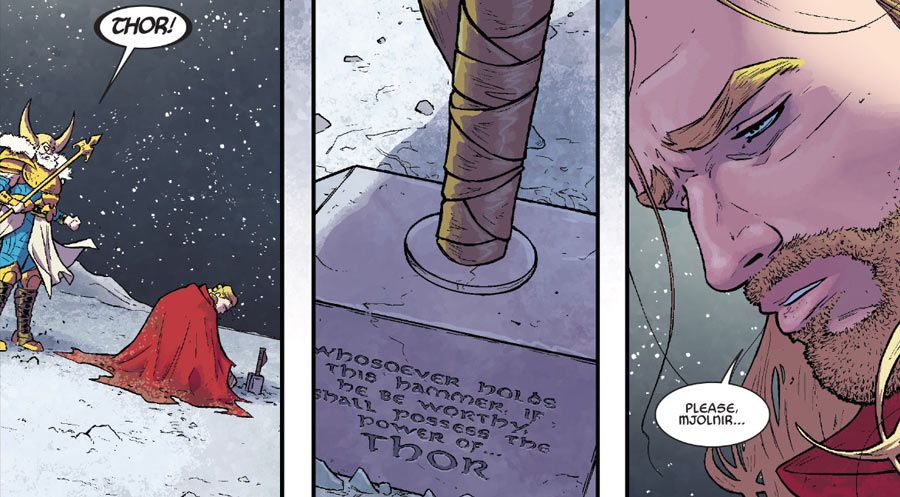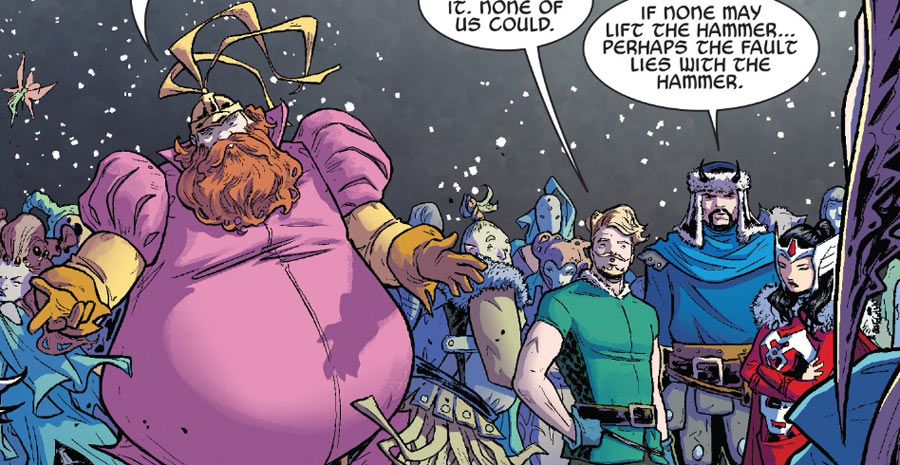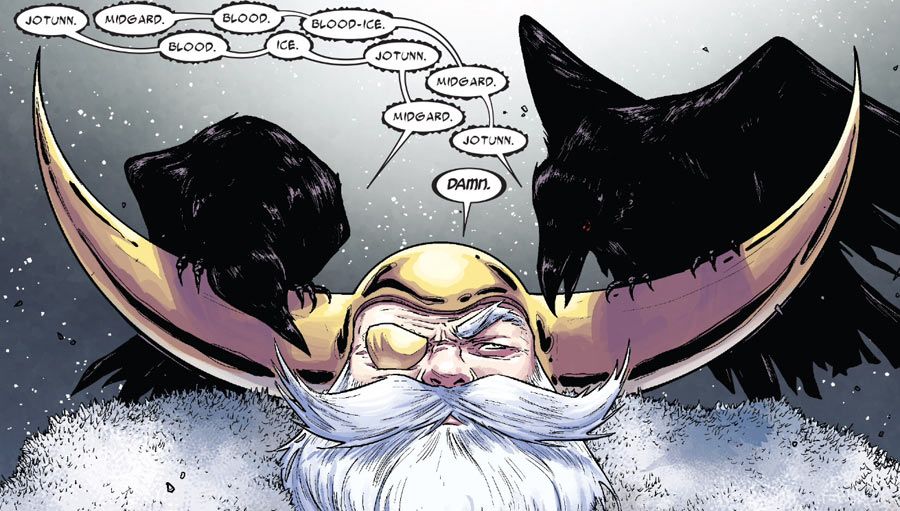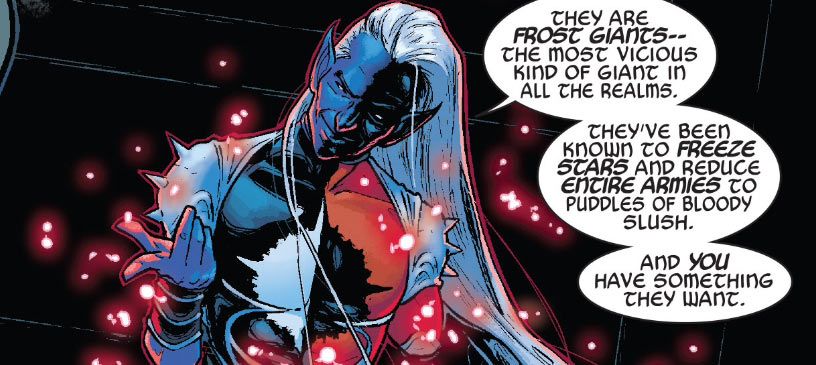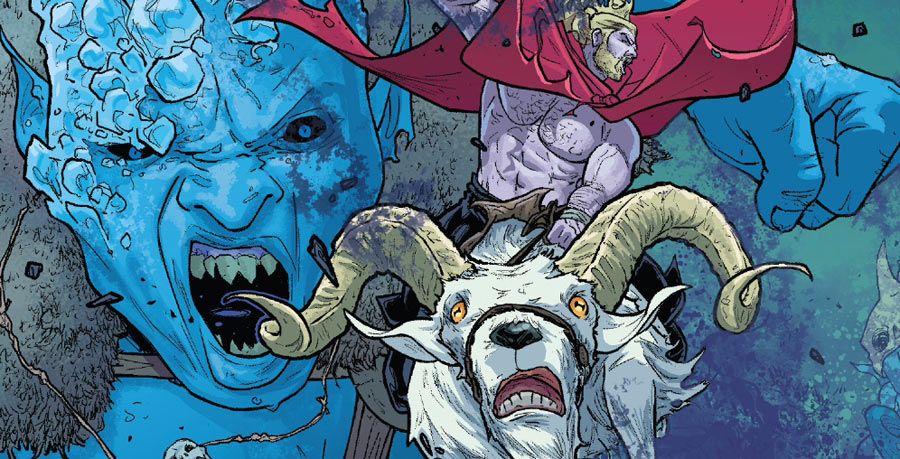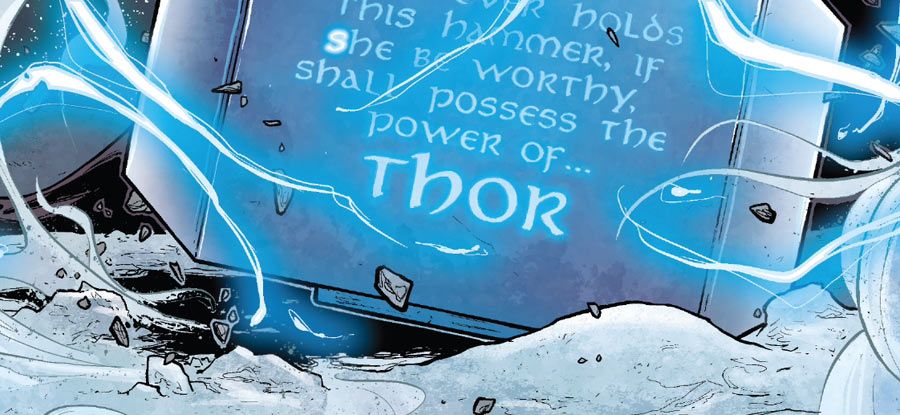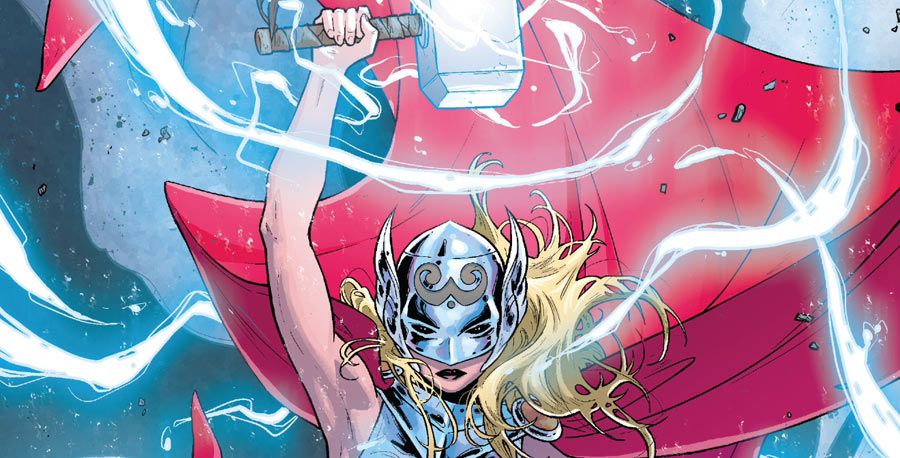SPOILER WARNING:The following article contains numerous spoilers for "Thor" #1, on sale now.
There's an all-new Thor in town, and her debut has garnered a lot of attention over the past few months. While her identity may not yet be known, one thing is for certain: She is worthy. "Thor" #1 by Jason Aaron, Russell Dauterman and Matt Wilson sets the stage for a whole new status quo for the Norse corner of the Marvel Universe and introduces a new hero, the mystery woman named Thor, into the mix.
This debut issue can be viewed as the beginning of a bold new era for Marvel's god of thunder, but it can also be seen as the continuation of the mighty adventure Aaron began in 2012 with "Thor: God of Thunder" #1. Actually, aspects of the book reach further back to the very beginning of the super hero Thor's career, while other key plot points alluded to in the fist issue took place outside of the Odinson's previous solo title.
RELATED: Aaron Details the Female Thor Debut, Simonson Talks Prior Changes
In order to put some of the events taking place in "Thor" #1 into context, we've compiled a list of annotations designed to clarify the many callbacks and references, obvious and obscure alike, found within this week's big debut issue.
Page 1, Panel 2
Roxxon submersible:: This massive -- and massively corrupt -- corporation has been a part of the Marvel Universe since 1974's "Captain America" #180. The energy corporation popped up in "Thor: God of Thunder" #12, when S.H.I.E.L.D. environmental scientist Roz Solomon discovered a whale graveyard in the middle of Antarctica -- not-so-conveniently located above a Roxxon underwater mining station. Thor went up against Roxxon and their bullish CEO Dario Agger in "Thor: God of Thunder" #19, creating a new archenemy in the process.
Page 2, Panel 4
Attack Sharks: This isn't the first time we've seen superpowered sharks in the pages of Aaron's "Thor." The writer previously sent a school of starsharks after a time-traveling Thor and his older self in "Thor: God of Thunder" #8.
Pages 4-5
Frost Giants: This race of larger than life warriors, who hail from the cold realm of Jotunheim, have been tormenting Asgardians since their debut back in 1965. They first showed up in the current run back "Thor: God of Thunder" #15, which revealed them to be aligned with another one of Thor's archenemies -- the dark elf Malekith. This deadly alliance ended the tenuous truce in place between Asgardia and the giants of Jotunheim. By the end of "Thor: God of Thunder" #17, the Dark Elves and Frost Giants would be in league together.
Page 6, Panel 1
Asgardia: Following the complete destruction of the realm of Asgard in 2010 during "Siege," Tony Stark helped the refugee Asgardians create a new, technology-based home. Asgardia remained on Earth, floating above the city of Broxton, Oklahoma. In the aftermath of Thor's intense battle against Roxxon in Broxton, the decision was made to relocate Asgardia away form Earth. Before he left, though, Thor gave the citizens of the tiny Oklahoma town his castle to make up for their ruined home.
Page 6, Panel 3
Odin: Thor's father Odin has been out of Thor's life for the past few years, following the return of his long forgotten brother Cul in 2011's "Fear Itself." Since then, he's only appeared once -- he had a one-panel cameo in "Thor: God of Thunder" #11 where he was seen praying for his son to defeat the vicious god butcher. Odin began his trek back to Asgardia in "Original Sin" #5.4
Freyja: Thor's mother, along with the goddesses Gaea and Idunn, took on the role of All-Mother following Odin's departure. They made the decision in "Thor: God of Thunder" #24 to relocate Asgardia away from Earth following the battle with Roxxon. With Gaea on Midgard and Idunn scouting for a new place to park the floating city, Freyja remained on Asgardia as the sole All-Mother.
Page 7, Panel 1
Unworthy Thor: Odin and Freyja's son, as well as the god of thunder, Thor became stripped of his worthiness after learning a devastating secret during the recently concluded "Original Sin" event.
Page 7, Panel 3
Mjolnir's inscription: Placed upon the mighty hammer by Odin himself as a way to help his son get past his boastfulness and arrogance, the inscription reads "Whosoever holds this hammer, if he be worthy, shall possess the power of... Thor."
Page 8, Panel 1
Enchantress: Odin wonders if Thor's sudden unworthiness might be the doing of Amora, a cunning Asgardian skilled in the mystic arts who has mastered the art of mental manipulation and fought many of Earth's heroes to a standstill.
Loki: Odin and Freyja's adopted son, and therefore the adopted brother of Thor, is also known as the god of mischief. Loki, currently inhabiting a younger, teenaged body, can be seen in the pages of his own series -- "Loki: Agent of Asgard."
Page 8, Panel 2
Freyja's Recap: Thor's mother explains to Odin the events of the limited series "Original Sin," which was first published over this spring and summer. The series focused on the murder of the Watcher, an alien being based on the moon and charged with observing all of Earth's happenings. Upon his death and the destruction of his eyes, all of the secrets the Watcher had witnessed were unleashed upon the planet.
Page 8, Panel 4
Nick Fury: The former S.H.I.E.L.D. director was revealed to also hold the title of "Man On the Wall" -- meaning he was Earth's first line of defense against extraterrestrial threats. As depicted over Thor's shoulder, Nick Fury whispered the secret into his ear that made him unworthy.
Page 9, Panel 2
Volstagg, Fandral and Hogun: The Warriors Three, this trio of Asgardian warriors have fought by Thor's side through countless battles and are among the bravest, most noble heroes in all of the Nine Realms -- yet even they could not budge the hammer. While she remains silent, Sif can be seen standing next to Hogun.
Page 10, Panel 1
Uru: This mystical metal found in Asgard was, as Thor described in "Thor: God of Thunder" #2, used by dwarves to forge the hammer.
Page 11, Panel 1
Hugin and Munin: These two ravens work for Odin, acting as scouts and going on reconnaissance missions for the All-Father to give him insight into far away events.
Page 11, Panel 2
Jotunn: Another name for Frost Giants.
Midgard: The Asgardian name for Earth -- also known as the place where Thor enjoys spending all of his spare time.
Blood and Ice: Hugin and Munin are referring to a Frost Giant spell that will resurrect the dead using a mixture of blood and ice.
Page 11, Panel 4
Bifrost: Nicknamed the Rainbow Bridge, this Asgardian wonder allows for travel from Asgardia to Midgard.
Page 12, Panel 4
Hall of Weapons: This location was first seen in "Thor: God of Thunder" #2, in a flashback scene to before Thor had become worthy to lift Mjolnir. The youthful and arrogant god tried to budge the hammer from its resting spot, but to no avail.
Thor's Home: As evidenced by his constant presence on Earth as both a member of the Avengers and a solo hero, Thor considers Midgard to be under his protection. Thor's fondness for Earth played a central role in "Thor: God of Thunder" #12, a standalone issue composed of various vignettes. Thor sat with a man during his final hours on death row, drank with army veterans, brought needed rain to a desert and visited with his old flame Jane Foster. During that visit, she told Thor about her battle with cancer. As of "Thor: God of Thunder" #25, Jane acts as Midgard's representative in the Congress of Realms in Asgardia.
Page 14, Panel 3
Dark Elves: Natives of the realm of Svartalfheim, the Dark Elves recently appeared in the "Accursed" arc of "Thor: God of Thunder." The elves broke their lord Malekith out of his cell in Niffleheim, the frozen land of Hel, in issue #13.
Malekith: When last we saw him in "Thor: God of Thunder" #17, the dark elf had been anointed the king of Svartalfheim. The All-Mother Freyja sought to force the former prisoner to finish serving his sentence, but a loophole allowed him to send a proxy to finish it for him.
Page 16, Panel 1
"Something of great value": A tale in "God of Thunder" #25 depicted one of young Thor's battles against the Frost Giants. Thor and his viking allies stopped the Frost Giants from resurrecting King Laufey by using a mixture of blood, ice and the warrior's skull -- a skull that modern day Roxxon stumbled upon in the final pages of the issue.
Page 16, Panel 4
Thor's Goats: While it's not clear if this is Toothgnasher or Toothgrinder, it's most certainly one of the goats that pulls Thor's Asgardian chariot. Seldom used by the hero nowadays, the two did appear in a flashback scene in "Thor: God of Thunder" #18, and Toothgnasher made a modern day appearance in issue #15.
Jarnbjorn: Before Thor was worthy enough to lift Mjolnir, he carried a Dwarven axe named Jarnbjorn into battle. The weapon first showed up during young Thor's scenes in "Thor: God of Thunder" #1, and has since gone on to play a major -- though apparently unrelated to this issue -- role in "Uncanny Avengers."
Page 19, Panel 5
One-Armed Thor: When readers first met the Thor of a far flung future in "Thor: God of Thunder" #1, they saw a god that was down a single arm. The grizzled old warrior instead snapped the arm of one of his enemies -- the Destroyer -- into place and leapt into battle against Gorr, the butcher of gods. Malekith is no stranger to slicing off limbs, either. In "God of Thunder" #13, he cut the arm off of a dark elf named Lady Waziria.
Page 21, Panel 6
New Inscription: As a prelude to its new wielder, the inscription -- previously seen on page seven -- has adjusted its pronoun usage.
Page 22
Thor: We don't know who she is, but she has arrived and is ready to bring the lightning!

